Panay island is located in the Western Visayas region and is comprised of four provinces, namely: Aklan, Capiz, Antique, and Iloilo. Iloilo and Antique are the southernmost provinces of the island.
I have always been fascinated by the land of the Ilonggos, and for this reason, I chose their enchanted and beautiful island as my place of retreat for this Holy Week. My trip to Iloilo would be some 16 hours of land travel by bus, and about 9 hours of sea travel by ferry. There will be two ferry rides, one in Batangas Port to Calapan Port in Mindoro, and the other in Roxas Port Mindoro to Caticlan Port in Aklan.
I arrived at the Cubao Bus Station at 10 am to catch the bus that would depart for Iloilo at 11 am. It is Holy Week time in the Philippines and people are crowding bus terminals to head to the provinces. Manila will be a ghost town in a few days with most of the the malls and stores closed so it's good to be away in the provinces.
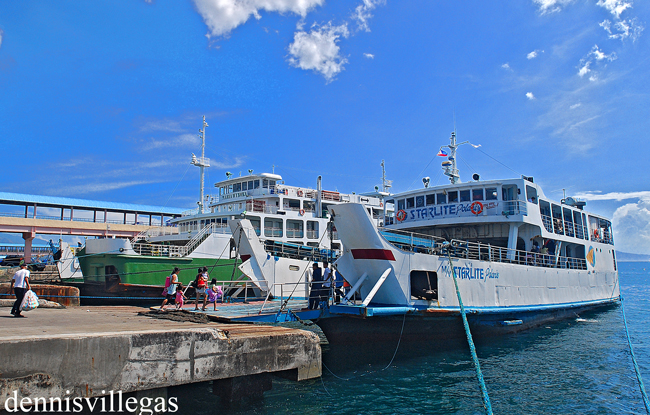
At 3 pm, our bus arrived at the Batangas Pier to board the Roro (Roll-on Roll-off) Ferry that would bring us to the island of Oriental Mindoro.
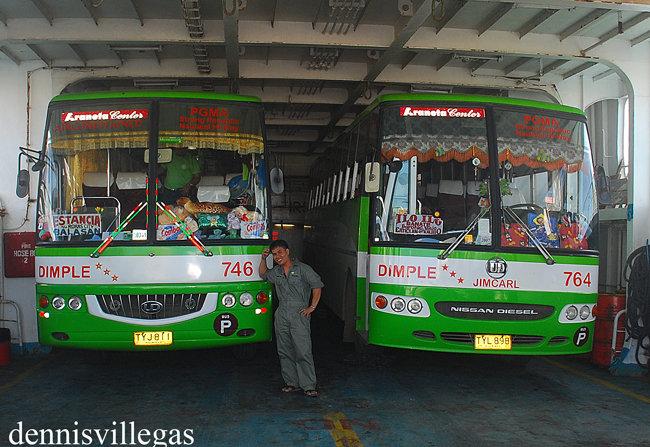
Bus#764 is the bus I was riding. We had to debark the bus to board the Roro. As you can see, the buses fit nicely inside the belly of the ferry. The ferry can accommodate five such buses, plus a few smaller vehicles. We proceeded to the second level of the ferry where seats are provided for the passengers.
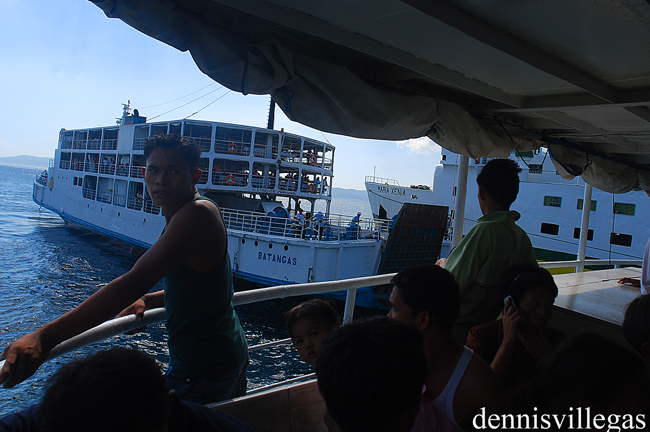
It was quite crowded in the ferry and I found it difficult to find a seat, so I just stood on the rails of the ship on the starboard side. Many fellow passengers were enjoying the beautiful views of the seas, while I took time to photograph some typical ship scenes. Here and there, aboard the ship, one can find sweethearts sitting together, old women with shawls around their heads, mothers tending to little babies, boxes and huge baggages around, and so on. It is always a wonderful experience riding with these folks, everyone seemed to be in an excited mood, and nobody seemed to be in too much of a hurry.

Leaving the Island of Luzon at 3:30 pm.
The day was vivid and clear--as well as hot and humid. It is always nice to view the seas, but the 3 hours sea-crossing may be boring for sometime, even if occasional wondrous scenes of green islands and sea rocks present themselves along the sea journey. I was hoping to see some dolphins or whales but instead found some wonderful little fishes jumping together out of the sea. I decided to while away the time to photograph some views.

Approaching the coast of Calapan, Oriental Mindoro. We had already passed the rough waters around Matuko islands along the Verde Island Passage. It was already five in the afternoon.
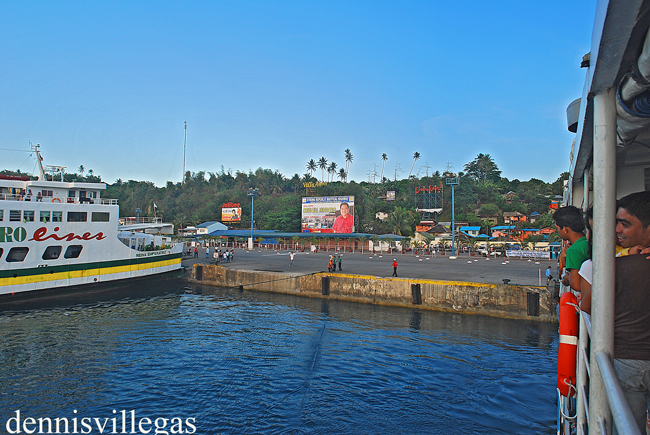
The Port of Calapan, Oriental Mindoro.
It took some three hours for the ferry to cross the Verde Island Passage. We had to debark now the ferry to continue our land travel along the coast of Mindoro.
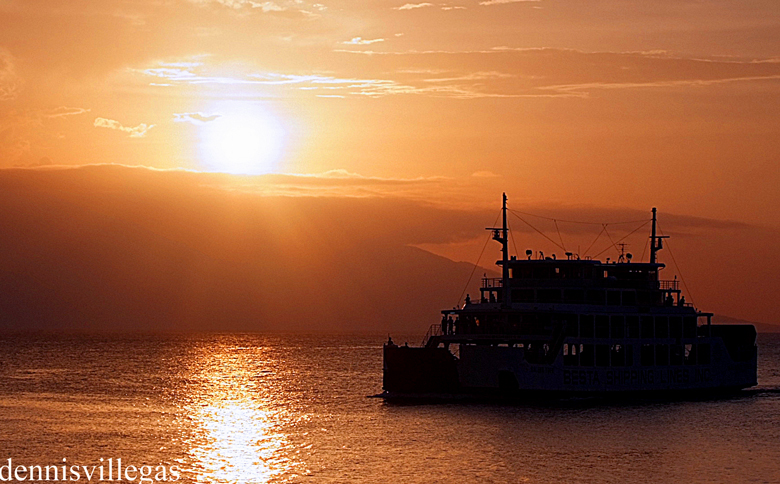
As we began to travel to the land of Mindoro, I took a long shot of the sunset at Calapan Harbor. It was almost 6 in the evening.
Arrival at Calapan Port, Oriental Mindoro
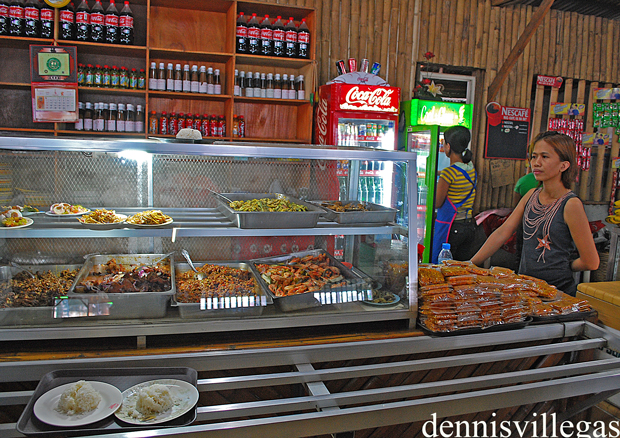

Each passenger--young and old--had to pay a terminal fee of 15 pesos each to enter the harbor. We had to wait sometime to wait for the buses to enter the ferry. At 12 pm, the ferry finally hooted its horns, signaling the beginning of our sea voyage. I went to the third level of the ferry to shoot some scenes, but couldn't get sharp pictures because of the choppy sea waters. The trip would be about four hours long, so I decided to just rest for a while to reserve my energy for the long sea journey.
A Midnight Crossing of the Seas aboard the ship MV Starlite Atlantic
Arrival at Calapan Port, Oriental Mindoro
We had to alight the Roro at the Calapan Port, Oriental Mindoro, and then ride our bus again for another five-hour, 110 kilometer drive to Roxas Port, Oriental Mindoro. After that, we will cross the sea again from Roxas Port, to Caticlan Port, Aklan. And then for the final leg of the journey, some six hours and 230 kilometers of torturous road journey from Caticlan Port, Aklan to Iloilo City. Now that's some some journey, isn't it?
So far, we had already had 6 hours of travel (3 hours by bus from Manila to Batangas Pier, and 3 hours by Roro crossing the Verde Island Passage). I was still fresh with still a lot of reserve energy for the next 19 hours of combined land and sea voyage.
In my excitement I forgot that I hadn't had any proper meal yet since we departed Cubao in the afternoon earlier. Inside the bus, I ate some Hansel biscuits and drank a Coke-in-Can. Seated beside me was an old man who I presumed to be an Ilonggo, and who spoke very little Tagalog. With him was his apo (grandson)-- a boy who I estimated to be about five year old-- seated on his lap. I offered them some biscuits and Coke but they declined.
The little boy was eating some itlog ng pugo (boiled quail eggs), which they bought from a vendor who entered the bus earlier. The little boy was quite nauseous (either because of the long ride or the eating of pugo) and all of a sudden, he vomited into the floor, messing one of my trousers' leg with some partially digested pugo. I offered some candy to relieve his nausea but he was quite groggy. The old man was saying sorry to me and I said it was alright. It happens every time. So a word of advice, my dear readers: if you are bringing a child into a long bus travel, bring a plastic container to contain the vomit so that you don't mess a man's trouser.
After a few minutes, the bus stopped in some God-knows-where unknown Mindoro village to let passengers eat, use the restrooms, or bask in fresh air. We stopped in front of a little restaurant where cooked foods are placed on pots and trays for the passengers to choose from. In gratitude for the drivers and kundoktors( bus stewards) who deliver customers, the restaurant gave them free meals. I have the feeling that we are actually the ones paying for their meals because the food was quite expensive. For example, I had to pay 60 pesos for one small platito of pork adobo, and 12 pesos for one cup of rice. But it was okay--we didn't have a choice, really. If only there were some Turo-turo eateries or tapsilogan nearby, but all I see around here are huge tracts of rice fields and mountains from a distance.
So far, we had already had 6 hours of travel (3 hours by bus from Manila to Batangas Pier, and 3 hours by Roro crossing the Verde Island Passage). I was still fresh with still a lot of reserve energy for the next 19 hours of combined land and sea voyage.
In my excitement I forgot that I hadn't had any proper meal yet since we departed Cubao in the afternoon earlier. Inside the bus, I ate some Hansel biscuits and drank a Coke-in-Can. Seated beside me was an old man who I presumed to be an Ilonggo, and who spoke very little Tagalog. With him was his apo (grandson)-- a boy who I estimated to be about five year old-- seated on his lap. I offered them some biscuits and Coke but they declined.
The little boy was eating some itlog ng pugo (boiled quail eggs), which they bought from a vendor who entered the bus earlier. The little boy was quite nauseous (either because of the long ride or the eating of pugo) and all of a sudden, he vomited into the floor, messing one of my trousers' leg with some partially digested pugo. I offered some candy to relieve his nausea but he was quite groggy. The old man was saying sorry to me and I said it was alright. It happens every time. So a word of advice, my dear readers: if you are bringing a child into a long bus travel, bring a plastic container to contain the vomit so that you don't mess a man's trouser.
After a few minutes, the bus stopped in some God-knows-where unknown Mindoro village to let passengers eat, use the restrooms, or bask in fresh air. We stopped in front of a little restaurant where cooked foods are placed on pots and trays for the passengers to choose from. In gratitude for the drivers and kundoktors( bus stewards) who deliver customers, the restaurant gave them free meals. I have the feeling that we are actually the ones paying for their meals because the food was quite expensive. For example, I had to pay 60 pesos for one small platito of pork adobo, and 12 pesos for one cup of rice. But it was okay--we didn't have a choice, really. If only there were some Turo-turo eateries or tapsilogan nearby, but all I see around here are huge tracts of rice fields and mountains from a distance.


As usual, it was a self-service restaurant where diners need to follow a line to buy their foods. The foods are then scooped from the trays and placed directly on your plate just like the way you see it in movies about prisons and asylums. One man complained that the scoop of adobo he was getting was very little and demanded a few more from the serbidora. The serbidora added a few slices of pork.
After the supper, we proceeded to the restrooms to unload some unwanted stuff. Restrooms along the national roads are always a challenge to use. They are dirty, smelly, and quite flooded. I don't know but some men preferred to urinate at the floor rather than into the urinals. I remembered my trip to Samar two years ago, where I employed an unusual technique to avoid smelling the ugly restroom stench. I had to cover my mouth and nose with my left hand while trying to steady my pee with my right.
Anyway, we had to resume our travel after the 20 minute break-time. The little boy was quite fine now and was already sleepy. It seemed that the break-time and fresh air did some wonders to relieve his nausea. Meantime the night had already descended and the konduktor decided to play some movies in the TV set installed in the bus. The movie was an old Tagalog action film starring Robin Padilla, killing all his 120 heavily-armed enemies--with only his one gun. But Padilla also got hit--in the arm, and for that, he rescued his chick and lived happily ever after. Ho-hum...
After the movie, the konduktor turned off the television and played some music. Most passengers decided to doze off. The lights of the bus were then turned-off. The seats could not be reclined(this was an old bus) , however, so everyone slept in sitting position. I was not much of a sleeper and much less a sitting-sleeper so I was just peering my eyes outside the window trying to make out figures in the darkness. Well, I could figure out some ricefields, and some faraway mountains, as well as some nipa houses along the road. These are the sort of typical countryside sceneries you'll see along the provincial roads.
Anyway, we had to resume our travel after the 20 minute break-time. The little boy was quite fine now and was already sleepy. It seemed that the break-time and fresh air did some wonders to relieve his nausea. Meantime the night had already descended and the konduktor decided to play some movies in the TV set installed in the bus. The movie was an old Tagalog action film starring Robin Padilla, killing all his 120 heavily-armed enemies--with only his one gun. But Padilla also got hit--in the arm, and for that, he rescued his chick and lived happily ever after. Ho-hum...
After the movie, the konduktor turned off the television and played some music. Most passengers decided to doze off. The lights of the bus were then turned-off. The seats could not be reclined(this was an old bus) , however, so everyone slept in sitting position. I was not much of a sleeper and much less a sitting-sleeper so I was just peering my eyes outside the window trying to make out figures in the darkness. Well, I could figure out some ricefields, and some faraway mountains, as well as some nipa houses along the road. These are the sort of typical countryside sceneries you'll see along the provincial roads.
At 11 pm we finally reached the Port of Roxas, Oriental Mindoro. It took us some five hours of land travel from Calapan to Roxas (some 130 kms). We will board the Roro again to cross the sea towards the Caticlan Port, Aklan.
While waiting for our bus to board the Roro, I whiled away sometime to look for a Sari-sari store (convenience store) around the Roxas area. There are many such stores in Roxas open till early in the morning, serving the passengers who will board the ferries. I bought some Hopia Mongo and a cup of coffee from this store.
Our kindly bus driver and kundoktor (bus attendant), taking a break in one of the Sari-sari stores.Our ship, the MV Starlite Atlantic
Each passenger--young and old--had to pay a terminal fee of 15 pesos each to enter the harbor. We had to wait sometime to wait for the buses to enter the ferry. At 12 pm, the ferry finally hooted its horns, signaling the beginning of our sea voyage. I went to the third level of the ferry to shoot some scenes, but couldn't get sharp pictures because of the choppy sea waters. The trip would be about four hours long, so I decided to just rest for a while to reserve my energy for the long sea journey.
A Midnight Crossing of the Seas aboard the ship MV Starlite Atlantic
At 12 am, our ship the MV Starlite Atlantic began to leave Roxas Port for our voyage to Caticlan, Panay Island. We will be crossing the Tablas Strait, the sea that separates the Mindoro and Panay islands. It will be some four and a half hour of sea voyage-- so I better find a seat to rest for a while. I did find one in the uppermost level of the ship. The ship was bigger than the one we boarded earlier, but it was also quite crowded. Thankfully, there were enough benches to accommodate everyone, plus a few extras for those wanting to sleep in a curl up fetal position. The ship was well ventilated by the sea air which made the sea voyage quite cool and comfortable.
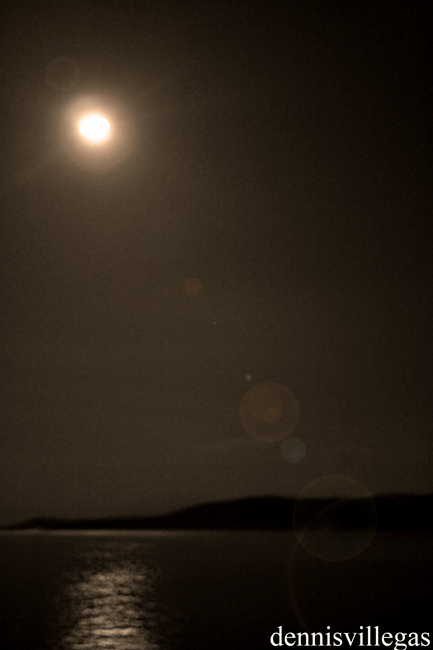
From above, the hazy glow of full moon gives some lovely romantic reflections unto the now gentle sea surface. The moon seemed to give a mellow ambiance into the genial mood of our sea voyage. Except for the moon and the streaks of lovely clouds, the sky was starless and the gentle winds just give a refreshing respite into the otherwise humid atmosphere.
From the horizon, I could figure out some lonely silhouettes of islands and islets in stark darkness against the ambient light of the moon. I was now so faraway from my family and friends, and despite the crowds in the ship, I felt alone.
A sea voyage on a moonlit night is able to make poets and composers out of men. I remember that Rizal created the poem "By the Pasig" while he was on a lovely moonlit night walk with his lovely Leonor Rivera. And certainly Beethoven was inspired to compose his famous "Moonlight Sonata" while seeing the gentle reflections of the moon on a beautiful lake in Switzerland.
Yet I am not a composer and a writer, and the length of land and sea travel already numbed my artistic senses for composition. I decided to occupy one of the empty benches and tried to sleep for a few hours, knowing that I still have several hours of travel ahead of me. At first I couldn't sleep, but my tired body finally gave up and I slept for two hours.
I woke up at around 2 am. I pulled myself to a sitting position on the bench and put on my leather jacket. I walked to the rail of the ship to view the horizon. I assumed that we are now on the very middle of the Tablas Strait. There was nothing much to see except for occasional silhouettes of islands from beyond the horizon.
I walked to the canteen and ordered a chicken sandwich and a hot 3-in-1 instant coffee which was very soothing and regenerated my now somewhat fatigued body. I noticed that most of my fellow passengers were sleeping along the benches while some--especially the men-- stood on the rails smoking and chatting. The atmosphere was quite relaxed and the only sound that you can hear were the hushed sound of the ship's engine as it silently glided its way deeper unto the middle of the sea, and the gentle sound of the waters as it quietly splashed into the ship's hull.
At 4 am, we finally reached the Port of Caticlan, Aklan, Panay Island. We debarked the ship to continue our land travel by bus. This was the first time that I was able to set foot in Panay island.
Now ahead of me is still some six hours and 230 kilometers of land travel through the provinces of Aklan, Capiz, Antique, and finally Ilo-ilo, where I decided to spend my Holy Week. The road condition from Caticlan to Ilo-ilo was mostly good with occasional under construction and dirt roads along the way. There are too many blind curves along the route mostly in the border of Capiz and Aklan.
Intersection road along the National Hi-Way, Kalibo Aklan
Our kindly bus driver was now replaced by a reserve driver who was quite experienced driving along these torturous roads in Panay island.
Restrooms along the provincial roads.
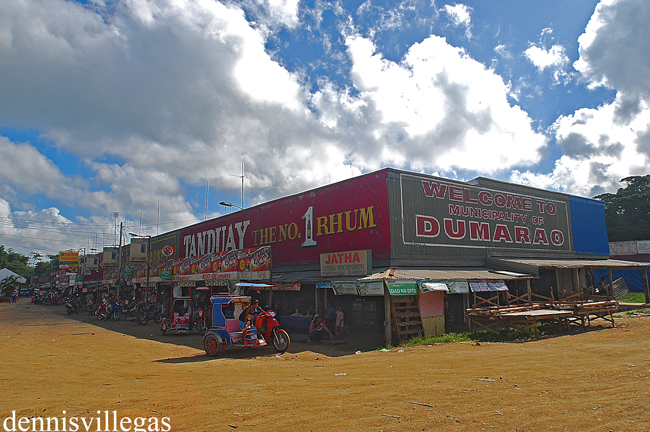
A mid-morning market scene in Dumarao, Capiz
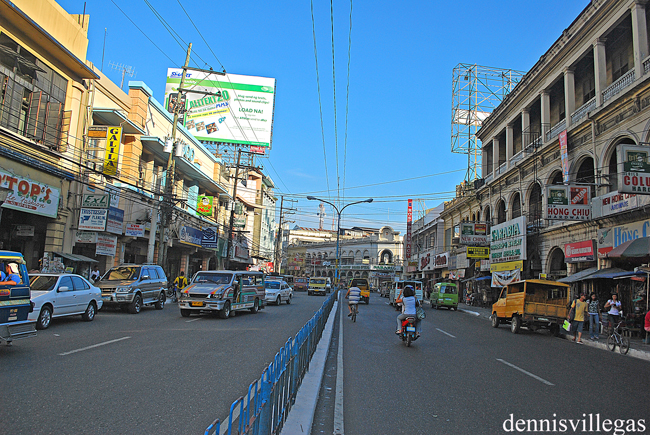
And finally, by 12pm, I reached Ilo-ilo City. How about that! Behind me now was more than 24 hours of combined sea and land travel--that's more than 500 kilometers of road travel--not including the hundreds of nautical miles covered by our two sea voyages! It's nice to finally reach my destination. But first I have to settle my things into a nice hotel. After the torturous journey, I think I deserve a good hotel accommodation in the city. And that means I have to rest for a while.

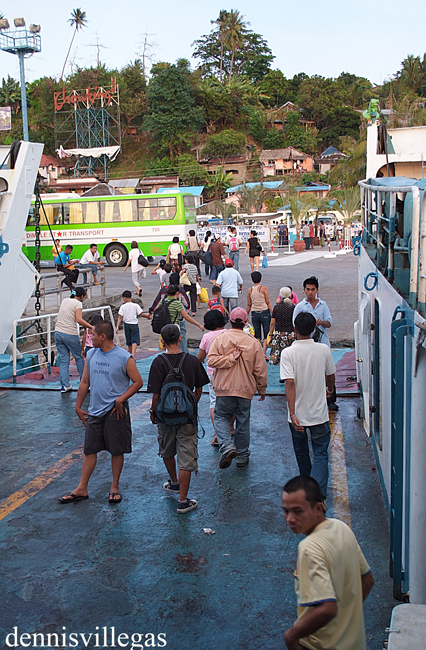
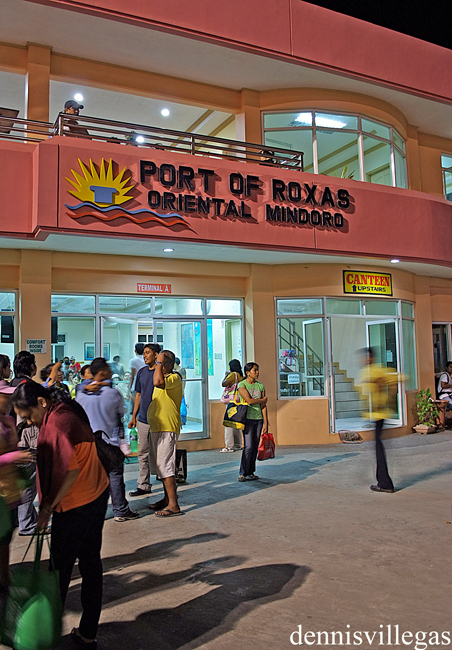
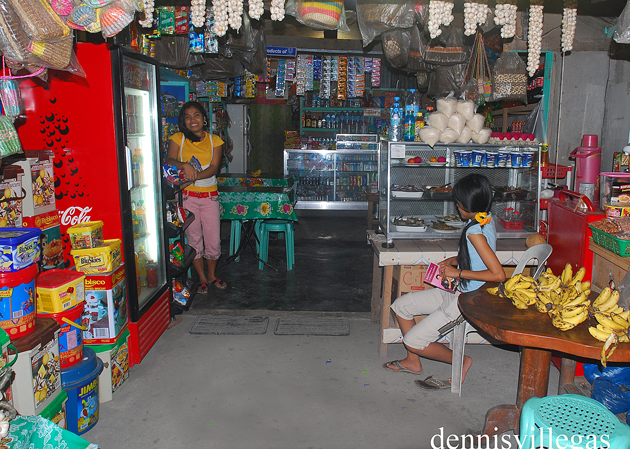
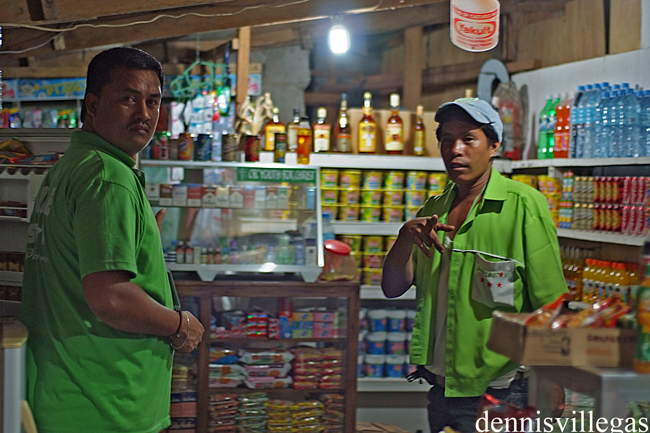
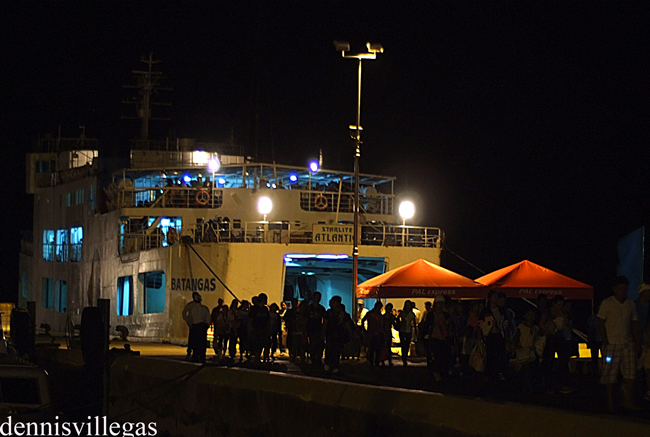
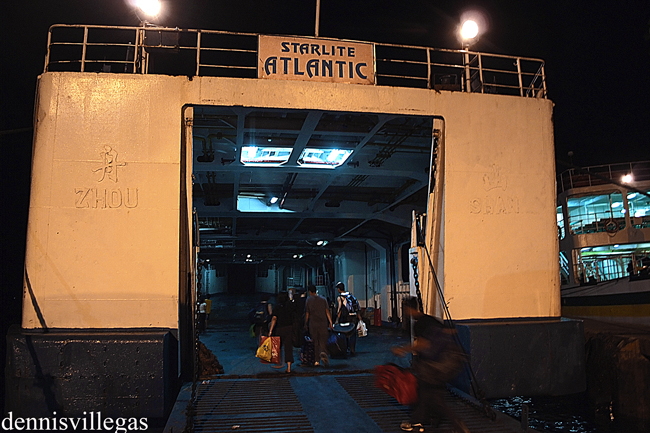
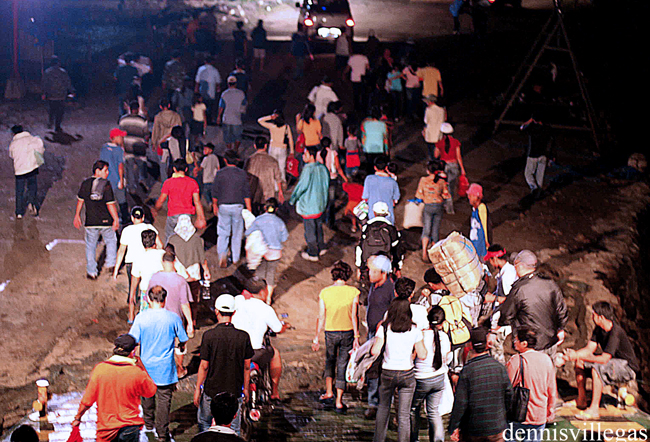

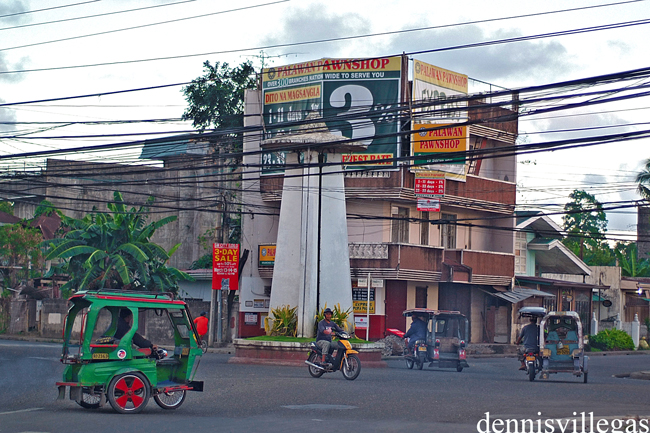
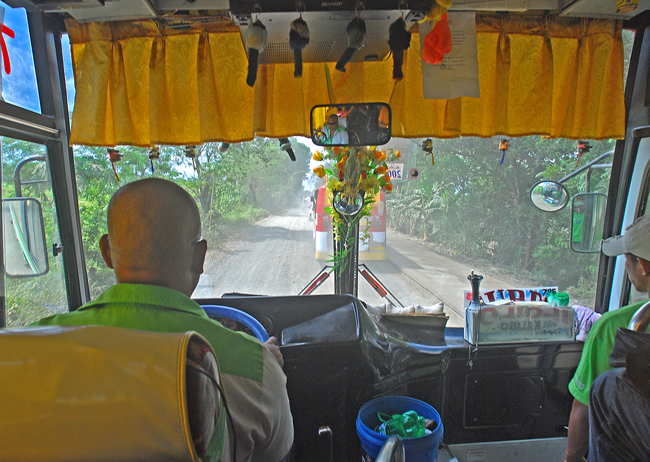
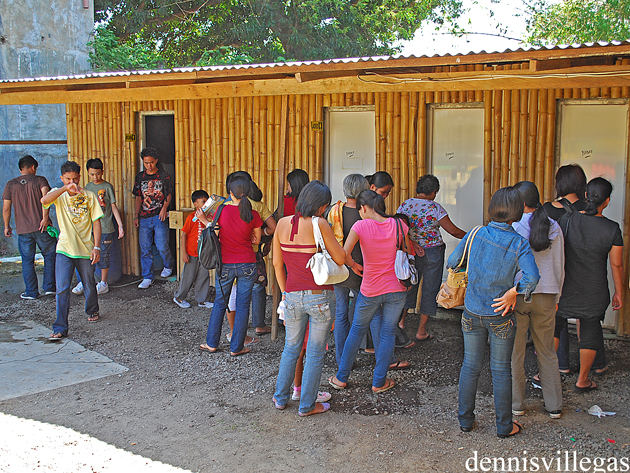
No comments:
Post a Comment